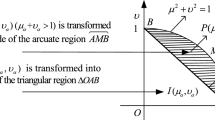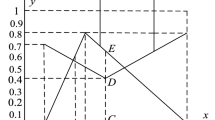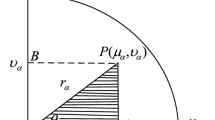Abstract
The main innovation of this paper is to transform Pythagorean fuzzy numbers (PFNs) into the analytic representation of centroid coordinates and hesitation factors through the transformation, and then the unified ranking method, distance measure and similarity with respect to PFNs are proposed using geometric method. These concepts can not only overcome some defects of existing methods, but also be applied to multi-attribute group decision-making problems. In this paper, the centroid coordinate representation of PFN is first introduced with regard to the hesitation region, when considering the degree of nonzero hesitation, the hesitation factor is proposed by comparing with the smallest element (0,1), and a new ranking method for PFNs is given by calculating the hesitation factor in the Pythagorean fuzzy number environment. Secondly, the distance measure and degree of similarity are put forward through the hesitation factor and centroid coordinates, and the Pythagorean fuzzy priority weighted average (PFPWA) operator is given by improving the priority weight parameter. Besides, the basic properties of PFPWA operator are discussed. Finally, the positive (negative) hesitation factor solutions, bidirectional projections and degrees of closeness for group comprehensive evaluation matrix are obtained, and a new TOPSIS method for dealing with multi-attribute decision-making problems is given under the Pythagorean fuzzy environment. The given example shows that the proposed method not only expands the scope of application and reduces the loss of some fuzzy information, but also eliminates the impact of abnormal data on the aggregation results by considering the priority of experts.




Similar content being viewed by others
Explore related subjects
Discover the latest articles and news from researchers in related subjects, suggested using machine learning.References
Atanassov, K.: Intuitionistic fuzzy sets. Fuzzy Sets Syst. 20(1), 87–96 (1986)
Chen, S.M., Tan, J.M.: Handling multicriteria fuzzy decision-making problems based on vague set theory. Fuzzy Sets Syst. 67(2), 163–172 (1994)
Hong, D.H., Choi, C.H.: Multicriteria fuzzy decision-making problems based on vague set theory. Fuzzy Sets Syst. 114(1), 103–113 (2000)
Yager, R.R.: Pythagorean fuzzy subsets. In: Proceeding Joint IFSA World Congress and NAFIPS Annual Meeting, Edmonton, Canada, pp. 57–61 (2013)
Yager, R.R., Abbasov, A.M.: Pythagorean membership grades, complex numbers and decision Making. Int. J. Intell. Syst. 28, 436–452 (2013)
Yager, R.R.: Pythagorean membership grades in multicriteria decision making. IEEE Trans. Fuzzy Syst. Publ. IEEE Neural Netw. Council 22(4), 958–965 (2014)
Zhang, X.L., Xu, Z.S.: Extension of TOPSIS to multiple criteria decision making with Pythagorean fuzzy sets. Int. J. Intell. Syst. 29(12), 1061–1078 (2014)
Zhang, X.L.: A novel approach based on similarity measure for Pythagorean fuzzy multiple criteria group decision making. Int. J. Intell. Syst. 31(6), 593–611 (2016)
Peng, X.D., Yang, Y.: Some results for Pythagorean fuzzy sets. Int. J. Intell. Syst. 30(11), 1133–1160 (2015)
Gou, X., Xu, Z.S., Ren, P.: The properties of continuous Pythagorean fuzzy information. Int. J. Intell. Syst. 31(5), 401–424 (2016)
Garg, H.: A novel correlation coefficients between Pythagorean fuzzy sets and its applications to decision-making processes. Int. J. Intell. Syst. 31(12), 1234–1252 (2016)
Garg, H.: A novel accuracy function under interval-valued Pythagorean fuzzy environment for solving multicriteria decision making problem. J. Intell. Fuzzy Syst. 31(1), 529–540 (2016)
Garg, H.: A novel improved accuracy function for interval valued Pythagorean fuzzy sets and its applications in decision making process. Int. J. Intell. Syst. 31(12), 1247–1260 (2017)
Garg, H.: A new improved score function of an interval-valued Pythagorean fuzzy set based TOPSIS method. Int. J. Uncertain Quantif. 7(5), 463–474 (2017)
Akram, M., Garg, H., Zahid, K.: Extensions of ELECTRE-I and TOPSIS methods for group decision-making under complex Pythagorean fuzzy environment. Iran. J. Fuzzy Syst. 17(5), 147–164 (2020)
Ren, P.J., Xu, Z.S., Gou, X.J.: Pythagorean fuzzy TODIM approach to multi-criteria decision making. Appl. Soft Comput. 42, 246–259 (2016)
Rahman, K., Abdullah, S., Ahmad, R.: Pythagorean fuzzy Einstein geometric operators and their application to multiple attribute decision making. J. Intell. Fuzzy Syst. 33, 635–647 (2016)
Peng, X.D., Ma, X.L.: Pythagorean fuzzy multi-criteria decision making method based on CODAS with new score function. J. Intell. Fuzzy Syst. 38, 3307–3318 (2020)
Xu, Z.S.: Dependent uncertain ordered weighted aggregation operators. Inf. Fusion 9(3), 310–316 (2008)
Yager, R.R.: Prioritized OWA aggregation. Fuzzy Optim. Decis. Mak. 8(3), 245–262 (2009)
Wei, G.W., Zhao, X.F.: Some dependent aggregation operators with 2-tuple linguistic systems with application to multiple attribute group decision making. Expert Syst. Appl. 39(5), 5881–5886 (2012)
Verma, R., Sharma, B.D.: Intuitionistic Fuzzy Einstein prioritized weighted average operators and their application to multiple attribute group decision making. Appl. Math. Inf. Sci. 9, 3095–3107 (2015)
Peng, D.H., Yang, Y.: Pythagorean fuzzy prioritized aggregation operators and its application in decision making. Granul. Comput. 55(18), 218–222 (2019)
Hwang, C.L., Yoon, K.: Multiple Attribute Decision Making: Methods and Application. Springer, Berlin (1981)
Walczak, D., Rutkowska, A.: Project rankings for participatory budget based on the fuzzy TOPSIS method. Eur. J. Oper. Res. 260(2), 706–714 (2017)
Yazdi, M.: Risk assessment based on novel intuitionistic fuzzy-hybrid-modified TOPSIS approach. Saf. Sci. 110(12), 438–448 (2017)
Shih, H., Shyur, H., Lee, E.: An extension of TOPSIS for group decision making. Math. Comput. Modell. 45(7–8), 801–813 (2007)
Ye, Y., Li, Y.: Group multi-attribute decision model to partner selection in the formation of virtual enterprise under incomplete information. Expert Syst. Appl. 36, 9350–9357 (2009)
Chen, C.T.: Extensions of the TOPSIS for group decision making under fuzzy environment. Fuzzy Sets Syst. 114, 1–9 (2000)
Tan, C.Q., Zhang, Q.: Fuzzy multiple attribute decision making based on interval-valued intuitionistic fuzzy sets. In: Proceeding of the 2006 IEEE international conference on systems, vol. 2, pp. 1404–1407 (2006)
Tan, C.Q.: A multi-criteria interval-valued intuitionistic fuzzy group decision making with Choquet integral-based TOPSIS. Expert Syst. Appl. 38(4), 3023–3033 (2011)
Liang, D.C., Xu, Z.S., Liu, D., et al.: Method for three-way decisions using ideal TOPSIS solutions at Pythagorean fuzzy information. Inf. Sci. 435, 282–295 (2018)
Sun, G., Guan, X., Yi, X., et al.: An innovative TOPSIS approach based on hesitant fuzzy correlation coefficient and its applications. Appl. Soft Comput. 68, 249–267 (2018)
Wang, G.J., Tao, Y.J., Li, Y.H.: TOPSIS evaluation system of logistics transportation based on an ordered representation of the polygonal fuzzy set. Int. J. Fuzzy Syst. 22(5), 1565–1581 (2020)
Wang, G.J., Duan, Y.: TOPSIS approach for multi-attribute decision making problems based on \(n\)-intuitionistic polygonal fuzzy sets description. Comput. Ind. Eng. 124(10), 573–581 (2018)
Duan, Y., Wang, G.J.: A FCM clustering algorithm based on polygonal fuzzy numbers to describe multiple attribute index information. Syst. Eng. Theory Pract. 36(12), 3220–3228 (2016)
Li, X.P., Tao, Y.J., Li, Y.H.: Decision making method for evaluating logistics companies based on the ordered representation of the polygonal fuzziness. J. Intell. Fuzzy Syst. 9(3), 3151–3166 (2020)
Li, X.P., Li, Y.H., Tao, Y.J.: Representation and aggregation of multi-source information of modern smart cities based on the intuitionistic polygonal fuzzy set. Int. J. Fuzzy Syst. 23(4), 967–983 (2021)
Sun, G., Li, X.P., Chen, D.G.: Ranking defects and solving countermeasures for Pythagorean fuzzy sets with hesitant degree. Int. J. Mach. Learn. Cybern. 13(5), 1265–1281 (2022)
Sun, G., Wang, M.X., Li, X.P.: Centroid coordinate ranking of Pythagorean fuzzy numbers and its application in group decision making. Cogn. Comput. 14(2), 602–623 (2022)
Funding
This work has been supported by National Natural Science Foundation of China (Grant Nos. 61463019, 61374009) and Natural Science Foundation of Hunan Province (Grant No. 2019JJ40062).
Author information
Authors and Affiliations
Corresponding author
Ethics declarations
Conflict of Interest
The authors declare that they have no conflict of interest.
Ethical Approval
This article does not contain any studies with human participants or animals performed by any of the authors.
Informed Consent
Informed consent was obtained from all individual participants included in the study.
Rights and permissions
Springer Nature or its licensor holds exclusive rights to this article under a publishing agreement with the author(s) or other rightsholder(s); author self-archiving of the accepted manuscript version of this article is solely governed by the terms of such publishing agreement and applicable law.
About this article
Cite this article
Sun, G., Luo, J. & Wang, G. TOPSIS Method Based on Hesitant Factor and Priority Weighted Operator in Pythagorean Fuzzy Environment. Int. J. Fuzzy Syst. 25, 831–850 (2023). https://doi.org/10.1007/s40815-022-01406-9
Received:
Revised:
Accepted:
Published:
Issue Date:
DOI: https://doi.org/10.1007/s40815-022-01406-9




